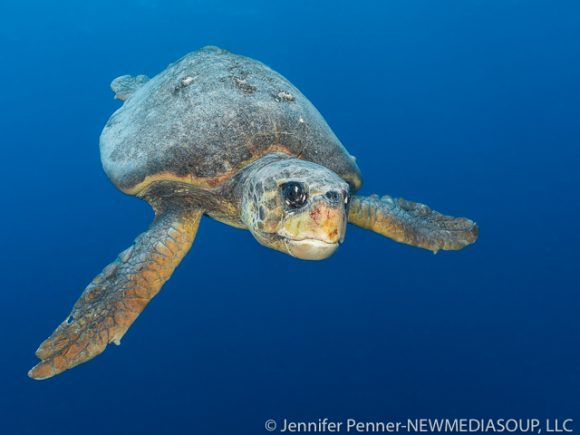
New underwater images from Bonaire! Bonaire never disappoints with turtles, octopus, eels, schools of fish and more!

New underwater images from Bonaire! Bonaire never disappoints with turtles, octopus, eels, schools of fish and more!

Newmediasoup, LLC produced a new sales and marketing video for Dreisbach Enterprises. This modern tool can be used by their sales and marketing staff to more accurately convey to the prospective customer the service offerings of DE. All photography – still, video and aerial – provided by Newmediasoup. Video editing, motion graphics, voice-over recording and music selection provided by Newmediasoup.
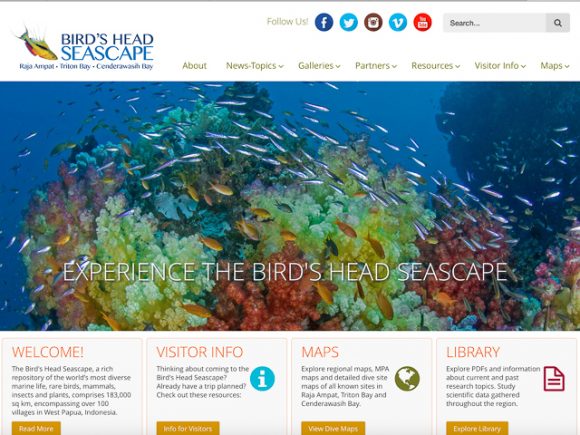
The Bird’s Head Seascape website gets a fresh, new look! This ultimate resource guide for the Raja Ampat-Cenderawasih Bay-Triton Bay regions is packed full of indispensible traveler info. An absolute must for travelers, snorkelers, divers, photographers and scientists.
Check out latest underwater GoPro video! 2016 was a fun-filled year for travel, and we captured some of the highlights here.
A recognized industry leader for creating engaging underwater video content, Joel is a regular speaker at DEMA, the Dive Equipment & Marketing Association (and largest trade show for the diving industry in the US). This year’s presentation, sponsored by Backscatter Underwater Video & Photo, How to Shoot Amazing Underwater & Topside Footage with Your Action Camera was met with enthusiasm by a packed audience.
We’ve compiled our best tips for capturing awesome GoPro footage here.
For any cold-water scuba diver, God’s Pocket Resort in British Columbia is at the apex. Spectacular views above and below the water treat the outdoors enthusiast to a memorable holiday. The resort is simultaneously rustic and pampering with daily meals and snacks to delight any foodie, and hospitality unequaled anywhere.
Aerial image taken by Joel Penner with a DJI Phantom 3 Pro.
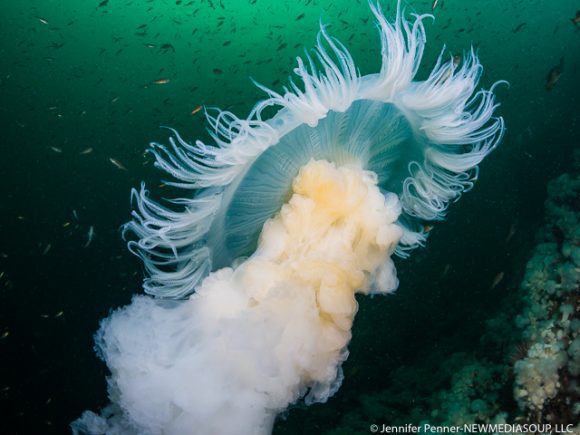
British Columbia, Canada, boasts some of the best cold-water diving in the world! Previously having had the opportunity to dive in the Browning Pass area, it was always on the short list to return. However, dive operators in that part of Canada are few and far between. We knew of God’s Pocket Resort from friends, and it was highly recommended for pristine cold-water diving and unequalled hospitality from the owners, Bill and Annie.
The tiny resort, which accommodates 12 guests, is like a big, warm hug from a free-spirited friend. If it’s a first visit, you instantly fall in love. If you are a returning guest, it’s like falling in love all over again! We hope we have the opportunity to return to such an amazing place!
Check out some of our images in the God’s Pocket gallery.
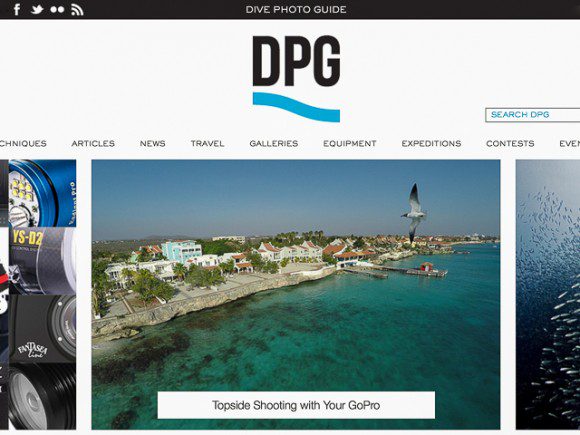
As scuba divers, most of our travels are centered around scuba diving and underwater photography. Much of our images captured during our adventure are of the underwater world. But more often than not, there is so much more to share; such as, breath-taking scenery, local culture, flora and fauna on land and such. Our latest article for DivePhotoGuide shares our tips and techniques for adding creativity and variety to your next vacation GoPro video using filters and lenses with Backscatter‘s FLIP4 System. Read our article, then immediately book your next trip! Your family and friends will LOVE your next vacation video!
35+ Practical Tips to Improve Your Underwater Photography
Seek The Like-Minded
Book your dive travel with a group that is dedicated to underwater image-making. Not only will you surround yourself with like-minded individuals to talk endless gear-geek chat, but the group leader will most likely have an established relationship with the resort/boat operator, which means getting you on the best sites for photographic opportunities when possible.
Local Knowledge, Know Before You Go
If you prefer to go it alone, do your homework well before your plane lands in paradise. Hire a local operator to be your guide. Knowing your goals, these locals can assist you to make your ideas for great imagery into reality.
Get Out Of The Dark Ages, Use Lightroom
Use Adobe Lightroom to organize and edit all of your underwater images. Period. Who’s signed up for a GoAskErin workshop?
Add To Your Library
If you only have one book on underwater photography, The Underwater Photographer By Martin Edge is a must!
Being A Student Is Great But Being A Practitioner Is Better
On-line communities like Wetpixel and Dive Photo Guide, books, how-to videos, underwater photo clubs, workshops and seminars (on land) are all great ways to learn underwater photography, but getting in the water and doing it is the best way to tackle the learning curve. Week-long workshops like The Digital Shootout will have your underwater photography at the next level in no time.
Good Buoyancy Is Key
Before you add an underwater camera system to the party, be a good diver with competent diving skills, this includes good buoyancy. Let’s face it, as underwater photographers, even though we may dive with a buddy, we are really solo diving. Knowing how to read computers and gauges is essential for dive safety, and good buoyancy will protect the reefs from unnecessary damage. Set a goal to shed some weight (lead, that is) during your next dive trip!
Avoid The Goo
When setting up your underwater system, make sure your camera lens is clean, and your port is free of unwanted micro debris, inside and out. You don’t want those specks showing up in your images. Underwater housing maintenance is a whole other topic! Good maintenance will keep your system shooting for a long time!
Which Camera Is Best?
The best camera is the one you are using. Your individual preferences, goals and needs will determine which system suits you best, and this can evolve over time. Befriend an underwater imaging gear pro who’ll be happy to help you navigate through the many daunting makes and models of underwater equipment. Support your local underwater imaging store. Developing a relationship with one of these gear pros will benefit you greatly in customer service and gear support for years to come.
Test And Pressure Check Before Diving
Assemble your camera, lens, housing, port and strobes/lights without distraction. Take a test shot to double check camera is operating, lens is focusing and strobes are firing. Then, before jumping in the water, dunk test your housing to insure it is water-tight.
For absolute assurance, install a vacuum system, like The Airlock, on your housing.
Get Your Underwater Camera System Neutral
Now that your buoyancy is dialed, get your underwater rig’s buoyancy dialed too! If your system is too negative, it will be challenging to shoot comfortably. Many manufacturers make buoyancy arms, or there are foam floats you can attach to your system’s arms to achieve the amount of neutrality you want. It’s a personal preference; some like their rig perfectly neutral, while other like it a bit negative. The amount of floatation may very well be different for macro and wide angle. Once you’ve got your configuration to your liking, take a photo for quick reference on future dive trips.
Shoot In RAW
When shooting in a format like JPEG, image information is compressed and lost. Because no information is compressed with RAW, you’re able to produce higher quality images, as well as correct problem images that would be unrecoverable if shot in the JPEG format.
Shoot In Manual Mode
If you’re not already doing so, invest the time and energy to learn to shoot your camera in manual mode, learning how ISO, aperture and shutter speed relate to each other. You will have more control over your images, instead of the camera’s evaluation based on an auto or semi-auto mode.
Digital Is Cheap – Shoot MANY Frames Of The Same Subject
In the days of film, the photographer was very limited to the number of exposures he/she had per roll. Now, memory cards are very affordable with bigger and bigger storage space.
Fire away at your underwater subjects and vistas to practice technique, getting those camera settings right for proper exposure, getting your subject in focus and overall composing a pleasing image. It’s not uncommon to take 50 frames of one set-up! When you’ve transferred the images to your computer, you can then determine which to keep and which to delete.
Turn Down The Brightness Of Your LCD Monitor
Don’t be fooled! The default brightness setting of all LCD monitors is fairly bright. For underwater photos, this can make an underexposed shot look good. Turn the brightness setting down to avoid being fooled.
Histograms Are Your Best Friend
Better yet! Instead of looking at your underwater image in your LCD screen to determine whether or not you got ‘the shot’, use your histogram for reference. Most modern cameras have an option to review the RGB histogram when reviewing your image. While the topic of understanding histograms is a class in itself, if you are not comfortable with using histograms to evaluate the exposure of your images, it’s highly recommended to invest the time to learn how to evaluate a histogram. For info on understanding histograms, check out our App, Histograms Explained-Tips to Understand Your Camera’s Histograms For Better Images in the iTunes App Store. Or, check out this article How to Read and Use Histograms.
Be A Fish Geek
Having some resources at your fingertips can be helpful to identify what you’re shooting on the reef. Further learning a little bit about the behavior of those endemic species can turn a fish butt shot into a fish ID shot into a captivating image!
Strobes & Lights
If you think underwater photography will be an avocation you’ll enjoy for years to come, then buy the best you can afford.
Macro: Jump Setting – A Good Place To Start
ISO 100 or 200. Aperture: f/18. Shutter Speed: 1/200. Use one strobe on full power.
Adjust your shutter speed and/or strobe power based on subject, set-up and conditions.
Macro: A Focus Light Is Essential
Not only will a focus light help your camera’s lens focus, it will help you see the tiny critters hiding in the shadows of the reef.
Macro: One Strobe Instead Of Two
For more detail, shadows and dimension, try using one strobe for your macro photography.
Macro: Move Your Strobe
General rule for even lighting: The distance from the front of your lens to your subject is the same distance of your strobe to your housing.
Macro: If It Has Eyes, It MUST Be In Focus
Focus is the ‘bread’ of bread and butter for underwater photography. If the subject of your macro image has an eye(s) showing, it must be in focus. Remember, digital is cheap, so don’t hesitate to shoot-shoot-shoot-review, make any necessary settings changes, shoot-shoot-shoot-review.
Macro: Move Beyond Fish ID
Aim for creating a compelling image, shooting it a bit differently than what’s already flooding the web. Show a behavior, pose, facial expression not commonly seen.
Macro: Be Uber-Selective About Your Backgrounds
Have your small wonder of the sea stand out with a background that is complimentary and non-distracting.
Macro: Video = Tripod
If your camera has video capability, and you’ll shoot an occasional underwater macro video, then get a tripod. Your family and friends will thank you for not making them watch shaky, wobbly video!
Wide Angle: Jump Setting – A Good Place To Start
ISO 100 or 200. Aperture: f/8. Shutter Speed: 1/125.
Wide Angle: Focal Point
In a wide angle scenic, focus on the nearest part of what is in the frame of your viewfinder.
Wide Angle: Available Light
When shooting without strobes, set a custom white balance in your camera. You still may need a bit of post editing, but your image out of the camera will be closer than without the custom white balance. The sun (when not behind clouds) is a big, bright light source – keep it at your back to illuminate your subject.
Wide Angle: Moving Subjects
To stop the action of a moving subject, set your shutter speed to 1/250 or faster. In manual mode you will have to adjust your ISO and aperture for correct exposure depending on the shooting conditions. To give a blurred-effect to your moving subjects, try a shutter speed of 1/80 or slower.
Wide Angle: Use Your Fins
The first thing we learn in underwater photography technique is ‘Get Close, Then Get Closer’. Use your fins to zoom-in to fill the frame for a captivating image.
Wide Angle: Move Your Strobes
General rule for even lighting: The distance from the front of your lens to your subject is the same distance (width) of your strobes.
Wide Angle: Unplanned Images With Divers
We refer to this as a ‘pick-up shot’. Whether you’re on the fringe of the shark action or at a deeper depth along the reef, watch your surroundings. As divers come and go through your frame, it could make for some wonderful images.
Composition: Apply The Rule Of Thirds
If your fish ID catalog is full, use the rule of thirds for placement of your subject in your frame. Having your subject elsewhere than the center of the image makes for a more pleasing composition.
Composition: Think Vertical
Reef scenes are often beautifully captured as vertical, or portrait-oriented images. Plan one entire dive where you only shoot vertical images. Not only will you see the reef differently, but you’ll challenge yourself.
Composition: Think Black & White
We live in a world of vibrant hues, but sometimes the monochromatic can have the same ‘wow’ affect. Our general rule for black and white: If our first reaction to a monochrome image is, “I’d like to see it in color.” Then it does not work as a black and white image. Simple, recognizable subjects work best for these images.
Composition: Add The Human Element
Adding a diver to your composition immediately gives your viewer a relationship to that image. It also provides scale to help the viewer comprehend exactly what he/she is viewing. Your dive buddy is also your underwater model. With patience and thoughtful communication, both topside and underwater, each of you can guide the other into position for engaging images.
Editing: Good Shooting & Good Editing Go Hand-In-Hand
Even the pros edit their images! Strive to get it “right” in-camera, but all images can benefit from some global adjustments; ie., white balance adjustment, contrast, clarity etc. Some may benefit from some localized adjustments like cropping, cloning etc. When you become a better editor, you’ll become a better shooter! A GoAskErin workshop is well-worth the time and money spent to learn how to edit your underwater photos.
Editing: Review Those Older Images
From time to time, go back in your library and review those older images. You may have forgotten that you shot certain ones, or you might see it in a whole different light than when you originally shot it. As software (Lightroom) upgrades progress with better tools, and our editing skills improve using those tools, you can potentially have more great images that you’d previously not given a second thought.
Sharing: Show Only Your Best
We want our family and friends to see our underwater adventures, no doubt. Spare your audience the timely chore of sitting through hundreds (or even thousands) of unedited images. In your Lightroom editing software, pick the images from your last underwater adventure that are your best, edit them, then share. Leave them wanting more!
Sharing: On The Web
Your personal goals will dictate how much of your underwater imaging you’ll want to share. Whatever you decide, be advised that once it is posted to the web, it lives forever. Anyone with a few skills and less-than-altruistic motives can use your image or video, without your permission.
Sharing: Photo Contests
Read the rules! All contests are different with different rules. Be aware of the terms of use for the images you are submitting.
Sharing: Put It To Good Use
We share our images with family, friends and the world to show the incredible beauty of the underwater world. However, without conservation efforts, these beautiful underwater realms will not exist for future generations.
“People protect what they love.” – Jacques Yves Cousteau
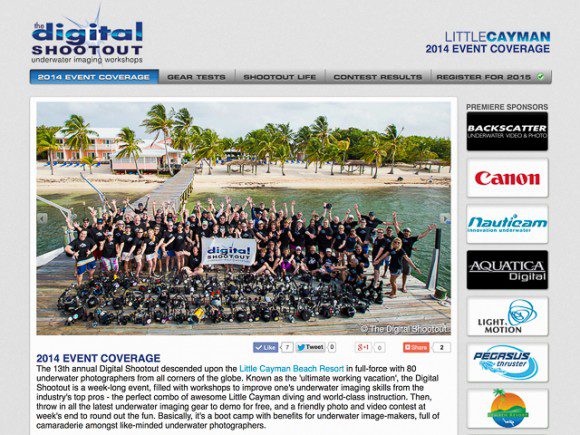
Joel & Jen recently returned from The Cayman Islands, on assignment working The 2014 Digital Shootout. Check out the full event coverage with photos, videos, gear tests and contest results!